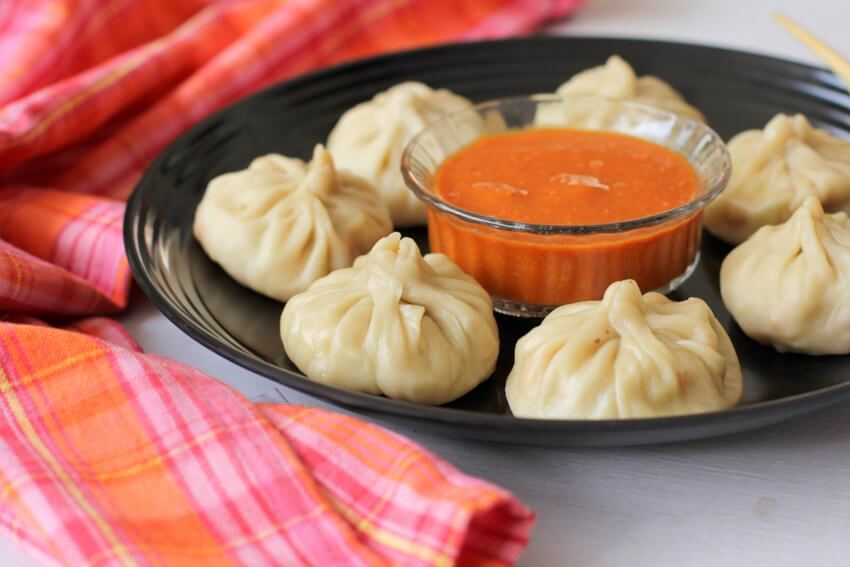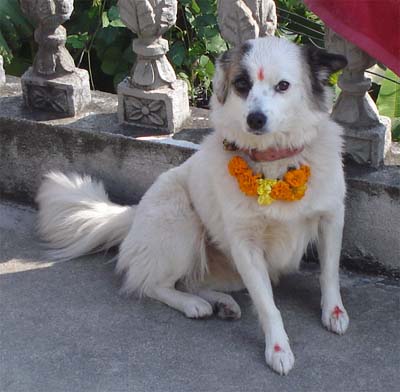 Momo is very popular food in Nepal. It is steamed meat or vegetables wrapped in flour dough. It is very popular in Nepal and generally eaten as snacks and tiffin. Momo can be both vegetarian and non-vegetarian. Especially around Kathmandu, buff Momo is popular. Nepali call buff momo for buffalo meat momo. However, chicken and motton (goat) momos are equally popular in the country. Momo is eaten with Momo achar. Sesame and Tomato achar is main achar of momo. Momo is also called Kothey and momo cha.
Momo is very popular food in Nepal. It is steamed meat or vegetables wrapped in flour dough. It is very popular in Nepal and generally eaten as snacks and tiffin. Momo can be both vegetarian and non-vegetarian. Especially around Kathmandu, buff Momo is popular. Nepali call buff momo for buffalo meat momo. However, chicken and motton (goat) momos are equally popular in the country. Momo is eaten with Momo achar. Sesame and Tomato achar is main achar of momo. Momo is also called Kothey and momo cha.
The main objective of this project is “Preparation and Distribution of mo: mo”. And ISA stands for International School Award and our school has participated in this project. For that We have to prepared MoMO and distributed to all students of jagat mandir and teachers. We students understand the value of food with its making procedures. We are altogether 47 students and 4 teachers (Khem Sir, Deepak Sir, Kamal Sir and Aarati Mam) involved and working in this project. We made ideas to make MoMo. The theme of our project is to prepare Mo: Mo and distribute to every students, teaching and non-teaching staffs of our school and as a part of social responsibility to help orphanage.
Orientation class:
In this class, Our project teacher Mr. Deepak Shrestha shared the plan made by him and other project teachers with us. He told that they had made plan to provide necessary materials to the orphanage.
Group Division:
our project teachers divided us into 4 groups (A, B, C, D). We each group were assigned different tasks required to complete in this project. There are different departments assigned to each group and project teachers.
Field visit:
One of the major parts of this project is field visit in local hotel to prepare Mo: Mo. In the hotel we went, the staffs gave us information about ingredients used in Mo: Mo, kima, pickle and also taught us how to give specified shape to Mo: Mos of different types.
Amount Collection:
We first collected the required data and information from students of Nursery to Grade 10, teaching and non-teaching staffs. Through this, we found that there are altogether 463 members in the JM family.
Utensils Collection:
We each group brought the required utensils asked by our project teachers.
Buying ingredients:
Group B and D went for shopping and bought all the required ingredients from money collected.
Cutting vegetables:
Group A and C were assigned the task of cutting vegetables.
Dough-making:
Firstly, we mixed the Maida and water in proper proportion in 3 or 4 batas. Then, we made dough from that proportion.
 After preparation of MoMo we distributed to all students turn wise. After distributing to all students we again distributed teachers. Then we all scattered and started to collect the wastes wrappers, materials and managed them properly in one place.
After preparation of MoMo we distributed to all students turn wise. After distributing to all students we again distributed teachers. Then we all scattered and started to collect the wastes wrappers, materials and managed them properly in one place.
This is the life time skill that I got through this project. From the money remained our project teachers have decided to provide necessary materials to the orphanage.
Total amount collected = Rs 33220
Expended = Rs 25720
Amount remained = Rs 7500
 We distributed lactogen to the volunteers of that organization (Nepal Children Organization). There were children from 2 months to 19 years. We distributed chocolates to small children. Clothes like woolen caps, socks etc. for small children brought by Binu Mam were provided to them on her effort. After distribution, we interviewed the volunteer and went back to school. Throughout this activity, I got to know the importance of parents.
We distributed lactogen to the volunteers of that organization (Nepal Children Organization). There were children from 2 months to 19 years. We distributed chocolates to small children. Clothes like woolen caps, socks etc. for small children brought by Binu Mam were provided to them on her effort. After distribution, we interviewed the volunteer and went back to school. Throughout this activity, I got to know the importance of parents.
Not only this much, we too planned to include and prepare international food with recipe and serve to all 8 graders and non-teaching and teaching staffs. After doing long research of international dishes, we selected Chole Bhature as our international dish.
Some of the amount we expended for preparation of Chole Bhature are-:
1) Departmental Store=Rs 2765
2) Vegetables= Rs 250
3) Curd= Rs 100
4) Masala= Rs 80
5) Catering= Rs 690
6) Plastic materials= Rs 330
Total amount = Rs 4215
1) Departmental Store=Rs 2765
2) Vegetables= Rs 250
3) Curd= Rs 100
4) Masala= Rs 80
5) Catering= Rs 690
6) Plastic materials= Rs 330
Total amount = Rs 4215
 We with the great help and support of Aarati Mam made Chole Bhature quickly and in convenient manner. Like the preparation of mo:mo it was not difficult. We smoothly and successfully completed the preparation of Chole Bhature. This dish was really very tasty and healthy too. Rather, all students and staffs added this dish once or more than that. This dish is very appealing. That's why we will try this recipe at home as well.
We with the great help and support of Aarati Mam made Chole Bhature quickly and in convenient manner. Like the preparation of mo:mo it was not difficult. We smoothly and successfully completed the preparation of Chole Bhature. This dish was really very tasty and healthy too. Rather, all students and staffs added this dish once or more than that. This dish is very appealing. That's why we will try this recipe at home as well.At last, I would like to thank our project teachers Deepak Sir , Khem sir, Kamal sir, and Aarati mam for supporting us in this projec and also i would like to thank our school for giving us this opportunity













